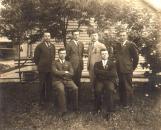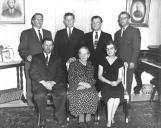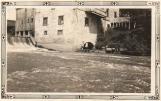1
During most of the 20th Century, the history of the mill has constantly been tied to the history of the members of the Légaré family, in particular Magloire, his spouse, Virginie Villiotte known as Latour, and their sons Donat and Philippe.Born in 1864, Magloire Légaré learned the profession of miller from his father, Magloire, a millstone sharpener for the Ogilvie company. From November 1885 until March 1, 1886, he worked as a miller at the Lauzon mill, which was located in the Saint-Eustache parish. On January 25, 1887, he married Virginie Villiotte known as Latour. At the time of his marriage, Magloire worked at Cléophas Aubé's sawmill, which was located close to the Saint-Eustache church.
In 1891, seigneur Charles-Auguste-Maximilien Globensky hired Magloire at the Saint-Eustache village flour mill. Magloire then established his family in a small wooden house on Saint-Eustache street, adjacent to the Presbyterian church.
In 1896, seigneur Globensky, Euclyde Duquette and Magloire Légaré became associated under the name of "Légaré, Duquette and company". A sawmill was then put into operation in a building perpendicular to the flour mill. In 1899, after seigneur Globensky refused to sell him the mill, Magloire decided to quit his job.
Around 1902, Duquette and Légaré operated the "red mill on the Chêne River, " a company that specialized in flour, boards and bricks. Magloire worked there until October 1907 when he bought what would become the Légaré mill. Gradually, he initiated his son Donat to the many tasks of a miller. In 1924, Magloire died, at the young age of forty years old.
9
Virginie Villiotte known as Latour, Magloire's widow, then inherited the property. She remained one of the rare female entrepreneurs in the region. With the help of her sons, she began to operate the mills. The disappearance of several mills in the region contributed to the increase in business for the Légaré mill.Beginning in 1934, Madame Légaré had to confront a significant problem, as the Corporation of the county of Deux-Montagnes began dredging the Chêne River. As its work negatively impacted the mills by decreasing the water power, Mme Légaré instituted legal proceedings against the Corporation for $62,800, but was unsuccessful. In addition, in 1952, she was compelled to lower the dam by thirty inches.










